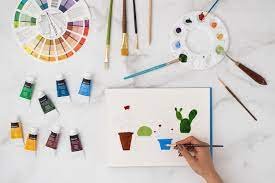Learning how to paint can be a rewarding and creative experience. Whether you are an absolute beginner or a more seasoned painter, there are ways to make the process easier and enjoyable.
Painting is a great way to express yourself visually, but it can also help improve concentration and stress relief. This article will provide tips on how to start painting classes for beginners, and provide helpful advice on getting started and continuing to improve your skills. From choosing the right supplies, to creating inspiring paintings, this guide will give you the tools necessary for successful painting. With a bit of practice, anyone can learn how to paint!
1. Choose a Medium
The first step in learning how to paint is deciding which medium you will use. Common options include watercolour, acrylics, oil paints and pastels. Each medium has its own unique characteristics, so it is important to consider the pros and cons of each before making a decision. Watercolours are often best for beginners because they require less equipment and have a forgiving nature, allowing mistakes to be easily corrected. However, acrylics and oils have their own advantages and are great for more experienced artists.
2. Gather the Right Supplies
Once you’ve chosen a medium, it is important to make sure that you have all of the necessary supplies. For watercolour painting, this includes paper, paintbrushes, a palette, watercolour paint, and a cup of water. For acrylics, you’ll also need a canvas, as well as an easel or board to place the canvas on. Oil painting requires some additional supplies such as solvents and varnishes. Make sure that you have everything you need before starting a project; having all the necessary supplies at hand will make the painting process go much more smoothly.
3. Familiarise yourself with the basics of Art
Before starting to paint, it is important to familiarise yourself with the basic elements of art. Knowing the basics of composition, colour theory and perspective can help you create more successful paintings. It’s also helpful to develop an understanding of the different techniques used in painting, such as dry brushing or blending colours. To learn more about these topics, consider taking an online art course or attending an in-person painting class.
4. Start with Basic Skills
It’s important to start by mastering the basics of your chosen medium. Begin by learning how to mix colours, and then practise drawing basic shapes like circles and triangles using different brushstrokes. If you’re using watercolours, practice blending colours to create interesting gradients. Once you have the basics down, you can begin working on more complex projects such as landscapes or abstract paintings.
5. Create Inspiring Paintings
Once you’ve practised and mastered the basics of a painting medium, it’s time to start creating some inspiring works of art. Think about what inspires you and then work on creating a painting that captures those emotions. Look for inspiration in nature, books, magazines, or photographs and use them to create an original piece of art. As you practise more, your skills will improve and the results will start to be even better!
6. Practise Often
Creating great paintings takes practice, so it’s important to find a space and time where you can paint often. Find ways to make painting a regular part of your routine; this could mean setting aside an hour or two each week for painting, or simply making sure that you have all the supplies you need on hand whenever inspiration strikes. The more often you practise, the better your paintings will become.
Some Tips That Can Help You:
1. Experiment with different techniques, such as dry brushing and sponging.
2. Keep a sketchbook to draw ideas before you start painting.
3. Take several breaks while you’re painting; this will help reset your focus and give your eyes a break from staring at the canvas.
4. Use high-quality supplies; this will make a big difference in the quality of your finished paintings.
5. Find a painting group or class to join, as this can help you stay motivated and get support from other artists.
6. Don’t be afraid to try new things and challenge yourself; this is how you grow as an artist!
Conclusion
Learning how to paint can be a rewarding experience, and it doesn’t have to be intimidating! The best way to learn how to paint is through trial and error. Paint whenever you have the opportunity, even if it’s just for a few minutes at a time. With the right supplies and a bit of practice, anyone can learn how to bring their creative vision to life. Follow these tips on getting started in painting and you’ll quickly see improvement in your skills.
Good luck and happy painting!













